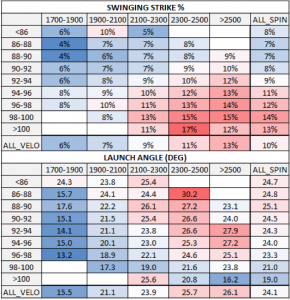
Investment in Low Spin Rates Paying Off for Cubs
With the Statcast Era long since established as more than just a fad, many major league teams are looking harder than ever at data surrounding their players’ performance. Just about every aspect of the game can be quantified and studied by front offices to aid in both the development and deployment of their players.
Perhaps one of the first numbers crunched after tracking technology was implemented in every MLB stadium in 2015 is spin rate. Tracked in revolutions per minute, spin rate is often indicative of how good a pitcher’s “stuff” is and can help explain why certain pitchers have greater success with different aspects of their craft.
As detailed by the chart below via Driveline Baseball, higher spin rates go hand-in-hand with an increased swinging-strike rate. So higher velocity plus higher spin yields the highest whiff percentages.

One of the more recent applications of spin rate has come as pitchers are trying to work more up in the strike zone with fastballs to combat the uppercut swings employed by hitters who subscribe to the theory of launch angle. A high spin rate keeps the ball from falling as much as it travels toward home plate, creating what’s know in pitching parlance as “ride.”
Conversely, a low-spin fastball is most effective when thrown down in the zone as it gives the ball a sinking action that often results in a lot of groundballs. Now that we’re about three and a half years into full-scale Statcast data being available, we are beginning to see a differing philosophy among front offices around baseball.
Some GMs and scouts, the Astros offer a good example here, are targeting high spin rate pitchers that generate a ton of strikeouts. On the other side of the coin, teams like the Cubs seem to be looking in the other direction in an effort to induce grounders that can be turned into outs by a solid defense.
As things stand in mid-June, the Cubs have six of the 30 lowest average four-seam fastball spin rates in baseball (minimum 250 pitches). Ranging from Mike Montgomery at 1,970 rpm (11th lowest in MLB) to Cole Hamels at 2,051 rpm (30 lowest), all six arms are solidly below the average spin rate for that offering.
Joining those two names are José Quintana, Kyle Ryan, Kyle Hendricks and Brandon Kintzler, all of whom hover right around 2,000 rpm. And while neither Hendricks nor Kintzler throw their four-seamer much, the concept holds for their sinkers as well. Hendricks owns the 26th lowest average spin rate on the pitch while Kintzler slots in at number 44.
Just one spot below Kintzler is Hamels while the trio of Montgomery, Ryan and Quintana also rank toward the bottom of the league in sinker spin rate. Even with Hendricks throwing more fastballs up in the zone of late, pitching at or below the knees is the common thread for all these pitchers. It should come as no surprise, then, that they are all turning in solid grounder rates in 2019.
Hamels and Ryan have posted groundball rates north of 50% this season and rank inside the top 61 in that category across MLB. Quintana (47.6%) is on pace to set a new career-best groundball rate this season while registering lower average spin rates on both his four-seamer (1,998 rpm) and sinker (1,963 rpm) than ever before.
Kintzler, who earned a reputation for high groundball rates while a member of the Brewers, has thrown his sinker more than 72% of the time in 2019 and garnered a 53.2% ground ball rate. Steve Cishek has given up less hard contact than any pitcher in baseball, largely due to his team-leading 57.1% grounder rate. Pedro Strop is tied for the lead, followed by the 53.6% generated by Tyler Chatwood.
That’s why the Cubs bullpen as a whole owns a 49.2% ground ball rate that paces all of baseball. As a whole staff, the Cubs find themselves second in the league with a club groundball rate of 47.4% that barely trails the Rockies (47.5%) for highest in the game.
In an era where the best way to keep a hitter from hitting a home run is to strike him out with a high-spin heater up in the zone, the Cubs have amassed a collection of pitchers who do the opposite. Whether by accident or design, Chicago has became a haven for sinker-ballers who get guys out on the ground. Of course, they do recognize the need for pitchers who miss bats.
That was supposed to be Brandon Morrow, with Carl Edwards Jr. helping to set him up. Injuries and inconsistency trashed those plans, so the Cubs found their swing-and-miss reliever in the from of Craig Kimbrel. The right-hander owns a career strikeout rate of 41.6%, and that includes a “down” 2018 campaign in which he only struck out a mere 38.9% of the batters he faced.
Kimbrel is nearing the completion of his ramp-up work in the minor leagues, after which he will give the Cubs an elite strikeout pitcher to pair with their abundance of groundball guys. And that’s the real key, whether we’re talking spin rate or any other metrics. Achieving balance and having pitchers with different skills and ability to match up really stabilizes the relief corps.
Because hitters have found ways to lift sinkers into the seats, it’s scary to see the Cubs leaning so heavily on guys who rely on getting contact on the ground to survive. But it looks for the time being like that notion is paying off for Chicago despite the high-wire act being performed almost nightly by the bullpen. Maybe Kimbrel provides them the safety net they’ve been lacking.

